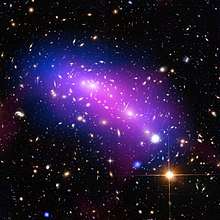MACS J0416.1-2403
MACS J0416.1-2403 is a cluster of galaxies at a redshift of z=0.397 with a mass 160 trillion times the mass of the Sun inside 200 kpc (650 kly). Its mass out to a radius of 950 kpc (3,100 kly) was measured as 1.15 × 1015 solar masses.[2] The system was discovered[3] during the Massive Cluster Survey, MACS.[4] This cluster causes gravitational lensing of distant galaxies producing multiple images.[5][6] In 2015, the galaxy cluster was announced as gravitationally lensing the most distant galaxy (z = 12). Based on the distribution of the multiple image copies, scientists have been able to deduce and map the distribution of dark matter.[7][8]
| MACS J0416.1–2403 | |
|---|---|
 Galaxy cluster MCS J0416.1–2403 imaged by the Hubble Space Telescope Credit: ESA/Hubble, NASA, HST Frontier Fields | |
| Observation data (Epoch J2000.0[1]) | |
| Constellation(s) | Eridanus |
| Right ascension | 04h 16m 09.9s[1] |
| Declination | −24° 03′ 58″[1] |
| Redshift | 0.420000[1] |
| Other designations | |
| MACS J0416.1-2403,[1] MACS J0416-2403, MACS 0416.1-2403, MACS 0416-2403, 1RXS J041609.9-240358[1] | |
Gallery
| Wikimedia Commons has media related to MACS J0416.1-2403. |
 MACS J0416.1-2403 contains a significant amount of dark matter, which leaves a detectable imprint in visible light by distorting the images of background galaxies.[9]
MACS J0416.1-2403 contains a significant amount of dark matter, which leaves a detectable imprint in visible light by distorting the images of background galaxies.[9] Very massive cluster of galaxies, MACS0416.1-2403, located roughly 4 billion light-years away.[10]
Very massive cluster of galaxies, MACS0416.1-2403, located roughly 4 billion light-years away.[10] Galaxy cluster MACS J0416.1–2403 is one of six being studied by the Hubble Frontier Fields programme.[11]
Galaxy cluster MACS J0416.1–2403 is one of six being studied by the Hubble Frontier Fields programme.[11]
References
- "Object No. 1 - MACS J0416.1-2403". NASA/IPAC Extragalactic Database.
- Jauzac, Mathilde; Eric Jullo; Dominique Eckert; Harald Ebeling; Johan Richard; Marceau Limousin; et al. (23 June 2014). "Hubble Frontier Fields: The Geometry and Dynamics of the Massive Galaxy Cluster Merger MACSJ0416.1-2403". Monthly Notices of the Royal Astronomical Society. 446 (4): 4132–4147. arXiv:1406.3011. Bibcode:2015MNRAS.446.4132J. doi:10.1093/mnras/stu2425.
- Mann, Andrew; Harald Ebeling (March 2012). "X-ray-optical classification of cluster mergers and the evolution of the cluster merger fraction". Monthly Notices of the Royal Astronomical Society. 420 (3): 2120–2138. arXiv:1111.2396. Bibcode:2012MNRAS.420.2120M. doi:10.1111/j.1365-2966.2011.20170.x.
- Ebeling, Harald; Alastair Edge; J. Patrick Henry (June 2001). "MACS: A Quest for the Most Massive Galaxy Clusters in the Universe". The Astrophysical Journal. 553 (2): 668–676. arXiv:astro-ph/0009101. Bibcode:2001ApJ...553..668E. doi:10.1086/320958.
- Diego, Jose M. (4 June 2014). "Free Form Lensing Implications for the Collision of Dark Matter and Gas in the Frontier Fields Cluster MACSJ0416.1-2403". Monthly Notices of the Royal Astronomical Society. 447 (4): 3130–3149. arXiv:1406.1217. Bibcode:2015MNRAS.447.3130D. doi:10.1093/mnras/stu2660.
- "New mass map of a distant galaxy cluster is the most precise yet". 24 July 2014. Retrieved 25 July 2014.
- Cho, Adrian (2017). "Scientists unveil the most detailed map of dark matter to date". Science. doi:10.1126/science.aal0847.
- Natarajan, Priyamvada; Chadayammuri, Urmila; Jauzac, Mathilde; Richard, Johan; Kneib, Jean-Paul; Ebeling, Harald; Jiang, Fangzhou; Bosch, Frank van den; Limousin, Marceau; Jullo, Eric; Atek, Hakim; Pillepich, Annalisa; Popa, Cristina; Marinacci, Federico; Hernquist, Lars; Meneghetti, Massimo; Vogelsberger, Mark (2017). "Mapping substructure in the HST Frontier Fields cluster lenses and in cosmological simulations". Monthly Notices of the Royal Astronomical Society. 468 (2): 1962–1980. arXiv:1702.04348. Bibcode:2017MNRAS.468.1962N. doi:10.1093/mnras/stw3385.
- "A cosmic kaleidoscope". Retrieved 23 March 2016.
- "Faint Compact Galaxy in the Early Universe". Retrieved 22 December 2015.
- "Hubble Frontier Fields view of MACSJ0416.1–2403". Retrieved 23 October 2015.
This article is issued from Wikipedia. The text is licensed under Creative Commons - Attribution - Sharealike. Additional terms may apply for the media files.